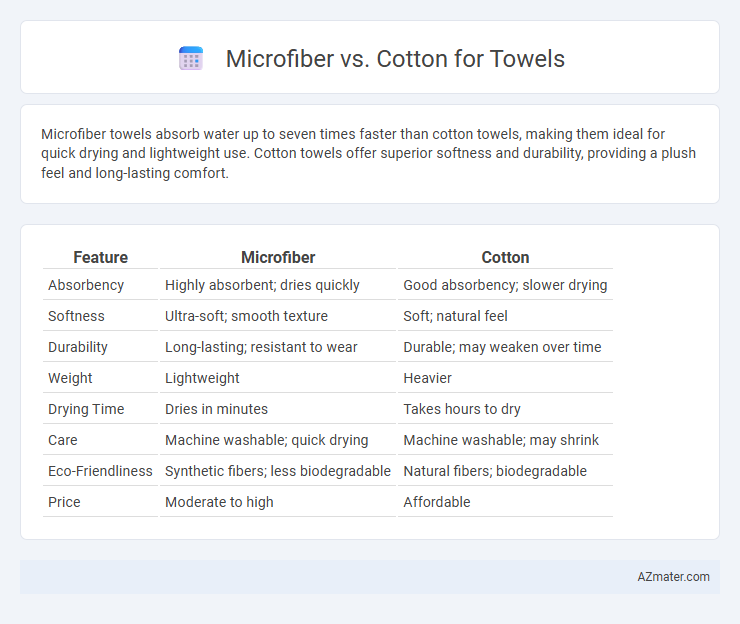Microfiber towels absorb water up to seven times faster than cotton towels, making them ideal for quick drying and lightweight use. Cotton towels offer superior softness and durability, providing a plush feel and long-lasting comfort.
Table of Comparison
| Feature | Microfiber | Cotton |
|---|---|---|
| Absorbency | Highly absorbent; dries quickly | Good absorbency; slower drying |
| Softness | Ultra-soft; smooth texture | Soft; natural feel |
| Durability | Long-lasting; resistant to wear | Durable; may weaken over time |
| Weight | Lightweight | Heavier |
| Drying Time | Dries in minutes | Takes hours to dry |
| Care | Machine washable; quick drying | Machine washable; may shrink |
| Eco-Friendliness | Synthetic fibers; less biodegradable | Natural fibers; biodegradable |
| Price | Moderate to high | Affordable |
Introduction to Microfiber and Cotton Towels
Microfiber towels are made from ultra-fine synthetic fibers, usually a blend of polyester and polyamide, known for exceptional absorbency and quick-drying properties. Cotton towels, crafted from natural cotton fibers, offer softness, breathability, and durability favored in traditional towel use. Choosing between microfiber and cotton depends on the need for moisture-wicking efficiency and portability versus natural fiber comfort and long-term reliability.
Material Composition: Microfiber vs Cotton
Microfiber towels are made from synthetic fibers, primarily polyester and polyamide, which are split into ultra-fine strands to create a dense, highly absorbent fabric. Cotton towels consist of natural cellulose fibers derived from cotton plants, offering softness and breathability but generally absorbing less moisture than microfiber. The engineered composition of microfiber allows for faster drying and greater moisture retention compared to the natural composition of cotton fibers.
Absorbency: Which Towel Performs Better?
Microfiber towels exhibit superior absorbency due to their ultra-fine synthetic fibers, which can hold up to seven times their weight in water, making them faster drying and more efficient at moisture retention compared to cotton towels. Cotton towels, specifically those made from Egyptian or Pima cotton, offer natural absorbency and softness but tend to hold less water and take longer to dry than microfiber alternatives. In performance comparisons, microfiber towels excel in quick water absorption and faster drying times, making them ideal for athletic and travel use where efficiency is crucial.
Drying Speed: Fast-Drying Capabilities Compared
Microfiber towels exhibit significantly faster drying speeds than cotton towels due to their densely woven synthetic fibers that absorb and release moisture quickly. Cotton towels, while highly absorbent, retain water longer, leading to extended drying times and potential dampness. The advanced moisture-wicking properties of microfiber enhance quick evaporation, making them ideal for travel, sports, and gym use where rapid towel drying is essential.
Softness and Comfort: User Experience
Microfiber towels offer superior softness and a lightweight feel, enhancing comfort during use by quickly drying without feeling heavy or rough on the skin. Cotton towels provide a plush, natural texture that becomes even softer with each wash, delivering a cozy and breathable experience preferred for sensitive skin. Users seeking a gentle and luxurious touch often favor cotton, while those valuing quick-drying softness and portability prefer microfiber.
Durability and Longevity of Towels
Microfiber towels exhibit superior durability and longevity compared to cotton towels due to their synthetic fibers that resist wear and tear over extended use. Cotton towels tend to lose softness and structural integrity faster, especially after repeated washing and exposure to moisture. Microfiber's dense weave and quick-drying properties significantly reduce the risk of mold and fabric breakdown, making them a long-lasting towel option.
Care and Maintenance Guide
Microfiber towels require low maintenance, as they dry quickly and resist odors, making them ideal for frequent use and easy washing at low temperatures without fabric softeners to preserve their fibers. Cotton towels need more care, including higher washing temperatures and occasional bleaching to prevent bacterial buildup and maintain softness, but they tend to retain water longer and take more time to dry. Proper care for microfiber involves gentle cycles and air drying to extend lifespan, while cotton benefits from regular deep cleaning and high heat drying to ensure durability and hygiene.
Eco-Friendliness and Environmental Impact
Microfiber towels use less water and energy during production compared to cotton, making them more eco-friendly in resource consumption. However, microfiber releases microplastics into waterways during washing, contributing to environmental pollution. Cotton towels are biodegradable and compostable but require significant water, pesticides, and land use, impacting ecosystems and carbon emissions negatively.
Cost Comparison: Microfiber vs Cotton Towels
Microfiber towels typically cost less upfront, with prices ranging from $5 to $15, while cotton towels often start at $10 and can exceed $40 depending on quality and brand. Microfiber offers a longer lifespan due to superior durability and faster drying times, reducing the need for frequent replacements and laundry expenses. Cotton towels may require more frequent washing and replacement, increasing total long-term costs despite their initial investment.
Choosing the Right Towel for Your Needs
Microfiber towels offer superior absorbency and quick-drying properties, making them ideal for active lifestyles and travel, while cotton towels provide a plush, breathable texture perfect for everyday home use and spa-like comfort. Consider microfiber towels for compactness and durability in outdoor or gym settings, whereas cotton towels excel in softness and long-term fabric quality for sensitive skin. Selecting the right towel depends on balancing performance characteristics like moisture absorption, drying time, and fabric feel to match your specific personal or environmental needs.

Infographic: Microfiber vs Cotton for Towel
 azmater.com
azmater.com